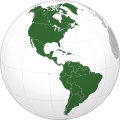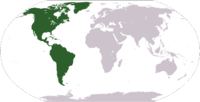- Cultural periods of Peru
-
This is a chart of cultural periods of Peru and the Andean Region developed by Edward Lanning and used by some archaeologists studying the area. An alternative dating system was developed by Luis Lumbreras and provides different dates for some archaeological finds.
Most of the cultures of the Late Horizon and some of the cultures of the Late Intermediate joined the Inca empire by 1493, but the period ends in 1534 because that marks the fall of the Inca empire after the Spanish conquest. Most of the cut-off years mark either an end of a severe drought or the beginning of one. These marked a shift of the most productive farming to or from the mountains, and tended to mark the end of one culture and the rise of another.
The more recent findings concerning the Norte Chico civilization are not included on this list, as it was compiled before the site at Caral was investigated in detail.
Period Dates Cultures Ceramic Late Horizon 1476 CE – 1534 CE Inca Late Intermediate 1000 CE – 1476 CE Chimú, Chincha, Cajamarca, Piura, Chancay, Chachapoyas, Chincha, Chiribaya, Chucuito,
Huaman Huilca, Ilo, Qotu Qotu, Pacacocha, Palli Marca, Piura, Sican, Tajaraca, Huaylas, Conchucos, Huamachuco, Rucanas, Chanka, Aymara nations, Ayabaca, Bracamoros, Huancabambas, Tallan culture, Huarco, Ichma, Parinacota, Cuntis, Chinchaycochas, Huarochiri, Kheswas, Tarmas, Paltas, CamanasMiddle Horizon 600 CE – 1000 CE Huari, Tiwanaku, Piura Early Intermediate 200 CE – 600 CE Moche, Nazca, Lima, Tiwanaku, Pechiche, Piura Early Horizon 900 BCE – 200 CE Chavín, Cupisnique, Late Chiripa, Paracas, Pechiche, Sechura Initial Period 1800/1500 BCE – 900 BCE Early Chiripa, Kotosh, Toríl (The Cumbe Mayo aqueduct was built c. 1000 BCE) Preceramic Period VI 2500 BCE – 1500/1800 BCE Norte Chico (Caral), Buena Vista, Casavilca, Culebras, Ventarrón, Viscachani, Huaca Prieta Period V 4200 BCE – 2500 BCE Honda, Lauricocha III, Viscachani, Period IV 6000 BCE – 4200 BCE Ambo, Canario, Siches, Lauricocha II, Luz, Toquepala II Period III 8000 BCE – 6000 BCE Arenal, Chivateros II, Lauricocha I, Playa Chira, Puyenca, Toquepala I Period II 9500 BCE – 8000 BCE Chivateros I, Lauricocha I Period I ? BCE – 9500 BCE Oquendo, Red Zone (central coast) Alternative timeline by Luis Lumbreras:
Period Dates Cultures Ceramic Tawantinsuyu Empire 1430 CE – 1532 CE Incas Regional States 1200 CE – 1470 CE Huari, Chimú, Chincha, Chanka Confederation Huari Empire 800 CE – 1200 CE Huari, Tiwanaku Regional Development 100 CE – 800 CE Moche, Nazca, Lima, Tiwanaku, Recuay, Gallinazo Formative 900 BCE – 200 CE Chavín, Vicus Preceramic Archaic 4000 BCE – 1200/1800 BCE Lithic 4000 BCE – 1500 BCE See also
- Amazonas before the Inca Empire
- The Pre-Incan Lost Pyramid of Puñay
 Indigenous peoples of the Americas
Indigenous peoples of the AmericasHistory 
European
colonizationBy country North AmericaGreenland · Canada · United States · Jamaica · Mexico · Central America · El Salvador · West Indies · PanamaSouth AmericaRelated topics Indigenous American studies · Indigenous languages · Indigenous Movements · Indigenous art · Artists · WritersCategory · Portal  History of the Americas
History of the AmericasHistory North America · Mesoamerica · Central America · Caribbean · Latin America · South America · Genetics
Settlement Indigenous peoples · Indigenous population · Pre-Columbian trans-oceanic contact · Discovery · Exploration · European colonization · Spanish colonization · French colonization · Portuguese colonization · British colonization · Columbian Exchange · DecolonizationSocieties Related Lists Chronology Archaeology of the Americas · North America by period · North American timelines · Mesoamerica by period · Mesoamerica timelineEra: By period · By region · Three-age system · Ancient history · Pre-Columbian · Classical Antiquity · Middle Ages · Modern history · Future References
Edward P. Lanning, 1967 Peru Before the Incas. Prentice Hall, Englewood Cliffs, N.J., ISBN 0-13-661595-3
Categories:- History of Peru
- Prehistory of Peru
- Archaeology timelines
- Andean civilizations
- History of indigenous peoples of the Americas
- Indigenous peoples of South America
- Archaeology of Peru
- Pre-Columbian cultures
Wikimedia Foundation. 2010.

